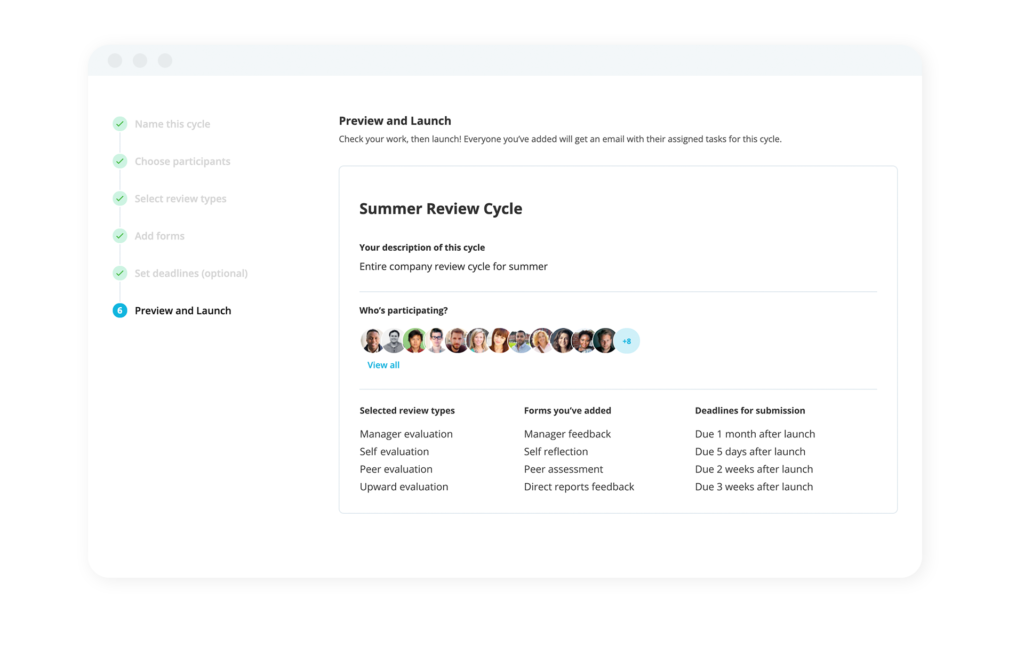Latest Blog Posts
Job enrichment: Practical ways to make it work

Job enrichment can solve an age-old problem: When employees feel stuck doing the same tasks every day are not engaged, are not content at work and are even more susceptible to burnout.
In this article, we’ll discuss how you can improve workplace engagement, motivation and even retention using one simple principle: job enrichment.
Start from the top with our performance review template today.What Is Job Enrichment?
Job enrichment is a method of job design that involves adding extra dimensions to a job to make it more interesting and motivating. The term was popularised by Frederick Hertzberg, a researcher working in the 1950s and 60s — but the same principles apply today.
How Does Job Enrichment Work?
The purpose of job enrichment is to expand the tasks that each employee performs, allow them to perform tasks in different ways, and ultimately give them more control over their work. This makes work more stimulating and helps to motivate employees to do their best work.
A key principle of job enrichment is to give employees more responsibility and increase the variety and complexity of the tasks they complete. Companies that want to introduce an enrichment programme usually begin by carrying out a job diagnostic survey (JDS), which is a formula that scores jobs based on factors like meaningfulness, autonomy and feedback.
Then, employers might introduce various strategies to add variety and interest to each job, to help motivate employees and increase their satisfaction at work.
Characteristics of Job Enrichment
Many job enrichment programmes are based on the Hackman & Oldham model (1974), which outlines five core job dimensions that affect job satisfaction:
Autonomy: how much control an employee has over their work
Skill variety: how many different skills employees use in their daily work
Task identity: the ability to perform a task from start to finish
Task significance: how directly the task impacts the organisation as a whole
Feedback: communication around the results of an employee’s work and recognition for doing a job well
Job enrichment strategies based around these key elements might include:
Combining tasks into meaningful units: Reorganising work to let employees take responsibility for entire projects instead of just one task can be a useful way to increase job satisfaction.
Letting employees work in teams: Allowing employees to work together helps them to develop new skills and understand how their role fits into the organisation’s activities as a whole.
Delivering and encouraging feedback: Actively telling your employees when they’re doing well can be a great motivator. Equally, listening to (and implementing) employee feedback shows employees that their ideas and voices are valued.
Eliminating micromanagement: In many organisations, processes are needlessly complicated by unnecessary approval steps, which can stand in the way of efficient workflows.
Give Potential Room To Grow With Personio

Automate your performance cycles to open up time for job enrichment with Personio today.
Find Out More
Advantages and Disadvantages of Job Enrichment
Focusing on enrichment can have some big advantages for your organisation and your employees alike — but there are some disadvantages too.
Job Enrichment Advantages
Here are some of the advantages of implementing an enrichment programme:
Increased motivation: Creating a collaborative work environment where employees work together and get to see the results of their work can help to increase employee motivation. Delivering feedback and recognition when employees do great work can also encourage them to take on new responsibilities and learn new skills.
Improved employee experience: Job enrichment allows employees to continuously learn and build on their skills — a key factor in the employee experience.
Lower turnover: Employees who are happy, engaged and motivated at work are much more likely to stay with your company for longer — which means job enrichment should be a big part of your retention strategy.
Uncovering potential: Giving employees the chance to experience work outside of their traditional job description could reveal hidden talents, and allows employees to grow within their role.
Job Enrichment Disadvantages
Enrichment also comes with some downsides, including:
Increased workload for employees: When you give employees the chance to work on different tasks outside of their normal roles, there’s a chance that you’ll simply overload them with work.
No guarantee of participation: Some employees are simply not interested in job enrichment, and just want to get their work done. This means you could end up wasting time and resources putting together job enrichment initiatives for employees who ultimately don’t participate.
Possibility of micromanagement: Taking on new tasks often means employees need to be in close contact with their managers. This can mean additional work for managers, who may feel the need to micromanage every step.
Job Enrichment Examples
Here are some examples of job enrichment so you can understand how it might work in practice in your organisation:
Example #1
Imagine a customer service department that receives a lot of calls from customers seeking after-sales care. When a customer requests a refund, the customer service representative has to send a request through to their line manager who reviews the case and decides whether it should be granted.
This creates a bottleneck in the process, delays things for the customer, and makes the representative feel like they’re only there to answer calls.
In this case, a useful form of job enrichment might be to give customer service reps the autonomy to decide when a refund should be granted. This both makes the process more efficient and gives the employees more responsibility — which could lead to better job satisfaction.
Example #2
For our second example, let’s say you have a copywriter in your marketing department. They create content for the company website based on briefs put together by the content manager.
Before being published, their content is proofread by an editor and then checked and optimised by the SEO manager.
Allowing the copywriter to own this process from start to finish might be a good form of job enrichment in this situation. This would mean they would create the brief themselves, then write the content, proofread it and ensure it’s in line with the company’s SEO guidelines.
5 Barriers to Job Enrichment
Job enrichment can have big results for organisations in terms of reducing absenteeism, increasing workplace satisfaction and even improving retention.
But these initiatives are not possible in all situations, and there are certain barriers that can stand in the way:
1. The Technical System
Existing systems within an organisation can present a barrier to job enrichment. For example, if an assembly line in a factory is physically set up to allow each employee to focus on one task all day, it can be difficult to increase the variety of tasks each worker performs.
2. The HR System
In some organisations, the HR system includes formalised job descriptions that can’t easily be changed. Collective labour agreements or roles defined by labour unions can also make it difficult to adjust an employee’s responsibilities.
3. The Control System
Organisational departments and internal systems like budgets, production reports and accounting practices can all play a role in making job enrichment more difficult. For example, assigning tasks that have traditionally been owned by one department to employees in another team can lead to internal struggles and competition.
4. The Supervisory System
Like any other HR initiative, job enrichment needs active and enthusiastic management participation to work. Trying to give employees more autonomy and responsibility can cause problems with certain managers, who may see this as their domain.
5. Individual Motivation
Job enrichment is effective for employees with a high need for growth, who welcome new challenges and the chance to learn new skills. However, some employees are simply not interested in this — which means these programmes won’t work for them.
Job Enrichment vs. Job Enlargement
The terms ‘job enrichment’ and ‘job enlargement’ are sometimes used interchangeably, but they’re not the same thing. Job enlargement is actually just one form of job enrichment, which involves adding additional tasks to an employee’s workload.
This allows them to gain experience in different areas, broadening their skill set and giving them more variety in their day-to-day work. It can also mean allowing them to participate in a process from start to finish, instead of just being responsible for one task.
However, job enlargement can have some downsides too. Some employees may feel that they are simply being expected to do more work for the same salary, which they might grow to resent. Plus, employees performing tasks that they have limited experience in can lead to errors and an overall decrease in productivity.
Continually Enrich Your HR Expertise
Want to learn more about what you can do to increase job satisfaction, motivation and retention in your organisation? Read our complete guide to employee experience, and our guide to boosting employee motivation to find out more.

